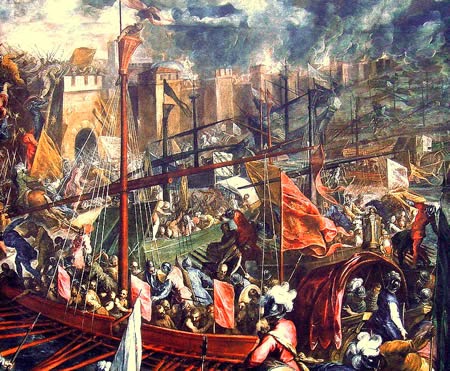World History
The Fourth Crusade had a devastating impact on the Byzantine Empire and its capital, Constantinople. For an enormous charge, the Venetians offered to transport the forces of the Fourth Crusade to Egypt to fight the Muslim “infidels.â€
But the Venetians never intended to attack the Egyptian Muslim rulers, with whom they had an extensive and lucrative trade. Instead after some maneuvering, the Venetians convinced the crusaders to attack and take Zara, a strategic and rich Adriatic port. The spoils from Zara were divided among the Venetians and the crusaders.
The crusaders then ignored the orders of Pope Innocent III not to attack Byzantium. In 1204 the crusaders, aboard Venetian ships, landed at Constantinople, then the richest city in Europe. The aged Venetian doge, Enrico Dandolo, personally led the crusaders, mostly French, into the city. Hundreds of Muslim worshippers were killed as well as several thousand Greek Christians, considered as heretics by Latin Catholics.
Having traded extensively with Byzantine merchants, the Venetians were familiar with the city and its treasures and embarked on extensive and systematic destruction, pillaging, and theft of the city’s wealth. To the present day, many art collections in Venice, including the famous bronze horses overlooking Piazza di San Marco, were stolen from Constantinople in 1204.
The crusaders installed Baldwin of Flanders as head of the new Latin Kingdom of Constantinople and replaced the Greek clergy with Latin clergy. The Latin Kingdom proved short-lived and after its collapse Greek Byzantine rulers returned to Constantinople, but the city never regained its former glory or power.
- Manuel Chrysoloras
Manuel Chrysoloras Manuel Chrysoloras was born in approximately 1350, in Constantinople, only about a century before the city— and its Eastern Roman Empire, or Byzantine Empire— fell to the Ottoman Turks under Mehmed II in 1453. He became...
- Crusades
Crusades In 1095 Pope Urban II incited the Crusades with a speech urging Christian armies to free the holy sites, especially Jerusalem, from Muslim control. The Crusades sparked a fire of religious fervor among thousands of young knights and other Christian...
- Schism Of 1054
Schism of 1054 The Schism of 1054 marks the official breach that separated Roman Catholic Christianity from Orthodox Christianity. It occurred when delegates of Pope Leo IX (1049–54) excommunicated Michael Keroularios, patriarch of Constantinople...
- The Siege Of Constantinople In 1453
The Siege of Constantinople in 1453 - The fall of Constantinople marked the end of the Byzantine Empire and the beginning of the Ottoman; an online collection of primary sources and articles. From the site: One of the most important events in world history,...
- Byzantine Empire
Byzantine Empire. This is a nice essay on the history of the Eastern Roman Empire. It is from Wikinfo. From the site: The Byzantine Empire or Eastern Roman Empire was the eastern section of the Roman Empire which remained in existence after the...
World History
Massacre of Constantinople
 |
| Massacre of Constantinople |
The Fourth Crusade had a devastating impact on the Byzantine Empire and its capital, Constantinople. For an enormous charge, the Venetians offered to transport the forces of the Fourth Crusade to Egypt to fight the Muslim “infidels.â€
But the Venetians never intended to attack the Egyptian Muslim rulers, with whom they had an extensive and lucrative trade. Instead after some maneuvering, the Venetians convinced the crusaders to attack and take Zara, a strategic and rich Adriatic port. The spoils from Zara were divided among the Venetians and the crusaders.
The crusaders then ignored the orders of Pope Innocent III not to attack Byzantium. In 1204 the crusaders, aboard Venetian ships, landed at Constantinople, then the richest city in Europe. The aged Venetian doge, Enrico Dandolo, personally led the crusaders, mostly French, into the city. Hundreds of Muslim worshippers were killed as well as several thousand Greek Christians, considered as heretics by Latin Catholics.
  |   |
Having traded extensively with Byzantine merchants, the Venetians were familiar with the city and its treasures and embarked on extensive and systematic destruction, pillaging, and theft of the city’s wealth. To the present day, many art collections in Venice, including the famous bronze horses overlooking Piazza di San Marco, were stolen from Constantinople in 1204.
The crusaders installed Baldwin of Flanders as head of the new Latin Kingdom of Constantinople and replaced the Greek clergy with Latin clergy. The Latin Kingdom proved short-lived and after its collapse Greek Byzantine rulers returned to Constantinople, but the city never regained its former glory or power.
- Manuel Chrysoloras
Manuel Chrysoloras Manuel Chrysoloras was born in approximately 1350, in Constantinople, only about a century before the city— and its Eastern Roman Empire, or Byzantine Empire— fell to the Ottoman Turks under Mehmed II in 1453. He became...
- Crusades
Crusades In 1095 Pope Urban II incited the Crusades with a speech urging Christian armies to free the holy sites, especially Jerusalem, from Muslim control. The Crusades sparked a fire of religious fervor among thousands of young knights and other Christian...
- Schism Of 1054
Schism of 1054 The Schism of 1054 marks the official breach that separated Roman Catholic Christianity from Orthodox Christianity. It occurred when delegates of Pope Leo IX (1049–54) excommunicated Michael Keroularios, patriarch of Constantinople...
- The Siege Of Constantinople In 1453
The Siege of Constantinople in 1453 - The fall of Constantinople marked the end of the Byzantine Empire and the beginning of the Ottoman; an online collection of primary sources and articles. From the site: One of the most important events in world history,...
- Byzantine Empire
Byzantine Empire. This is a nice essay on the history of the Eastern Roman Empire. It is from Wikinfo. From the site: The Byzantine Empire or Eastern Roman Empire was the eastern section of the Roman Empire which remained in existence after the...
